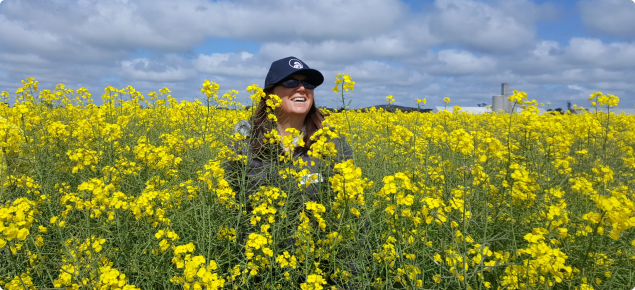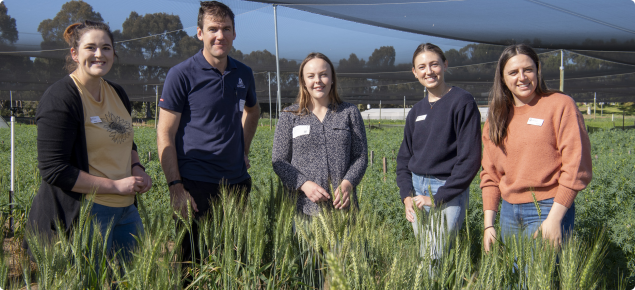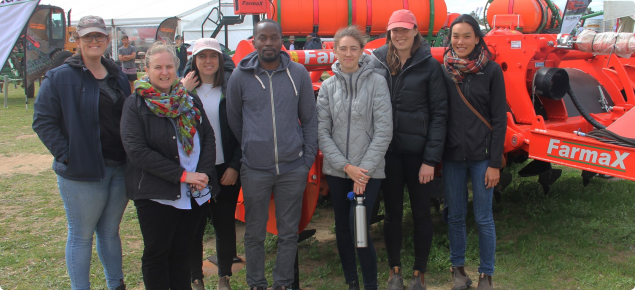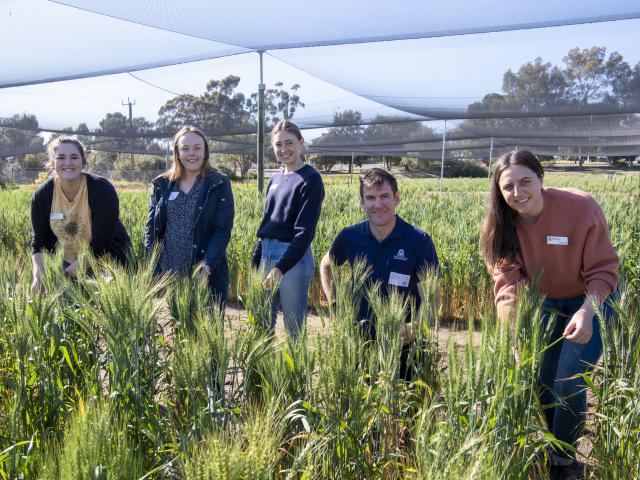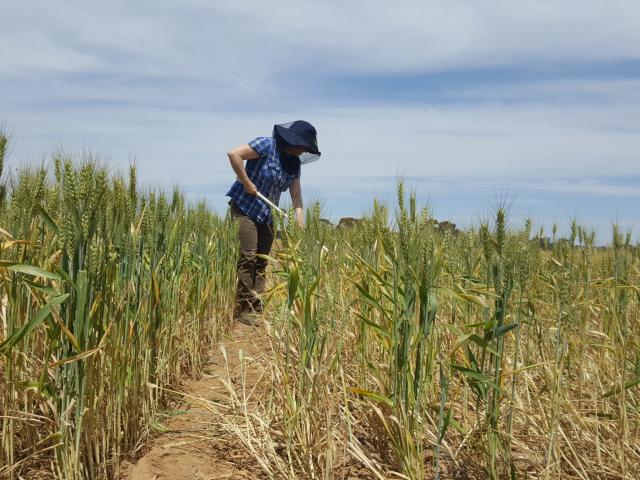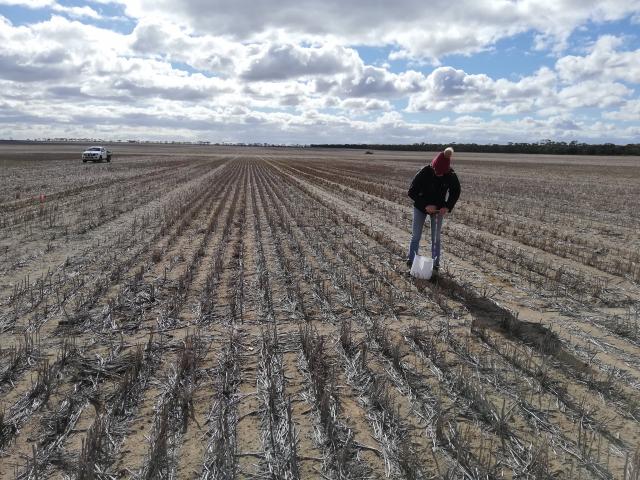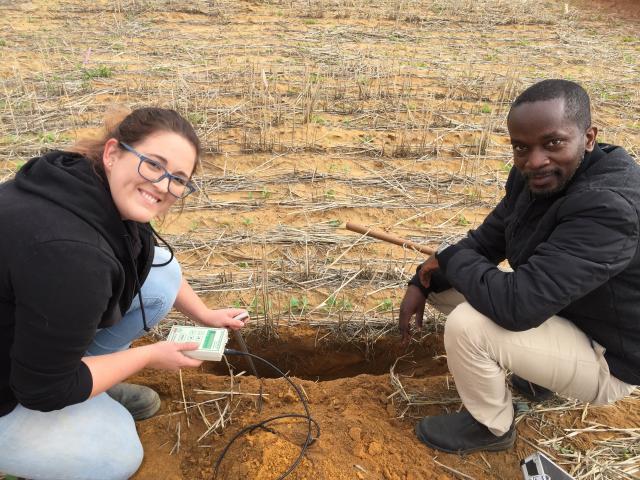Boosting regional agronomy capacity
Over the period 2016–2021 the project boosted regional agronomy capacity by developing the skills of recent entrants to the grains industry while they undertook regionally-based research, development and extension activities.
Based in Albany, Esperance, Merredin, Northam and Geraldton, the team worked across five Western Australian port zones and focused on an array of locally identified issues of priority to the grains industry and farming systems.
Over the course of the project DPIRD mentored 19 early-career scientists to develop skills in grains and farming systems research, development and extension. The program enabled participants to transition to new roles across the grains industry and into farming systems R&D.
Research, development and extension
The project was involved in a wide range of regional priority-aligned project activities in collaboration with grower groups and/or other research projects. Access to trial reports and focus areas for the project's research, development and extension are summarised below.
Trial reports
All trial and demonstration reports on these and other activities can be found at the GRDC Online Farm Trials website.
Click on 'Search', scroll down to 'Related Programs' and scroll down further to 'Regional Research Agronomy' and tick the box. At the top of the Search list click the green 'Go' button to view the list of trials from the project.
Pest and disease surveillance and management
With the team of agronomists dispersed across the regions, capacity to undertake pest and disease surveillance was significantly increased. The project contribution included:
- over 500 reports of pests and diseases , including collection of samples for resistance testing and area freedom surveillance for exotic pests and diseases.
- oat disease survey of Kwinana West port zone in 2018 complementing and supporting work undertaken by the National Hay Agronomy project's pathology surveillance program
- surveys conducted with growers and consultants to review existing crop protection decision support tools to inform future investment
- a multifaceted approach to sclerotinia management in season through petal testing, apps, remote sclerote monitoring for apothecia and spray trials.
Publications
- 2019 GRDC Grains Research Updates: Validating the SclerotiniaCM App For Managing Sclerotinia In Canola
- Was there an economic return from fungicide application for management of spot type net blotch in Muntadgin in 2017?
Managing snails and other invertebrates
A range of snail management activities were conducted including:
- Monitoring using time-lapse cameras to correlate snail activity and lifecycles to local weather conditions. This work added value to other projects being carried out by DPIRD research scientist Svetlana Micic, Stirlings to Coast Farmers and SEPWA, resulting in improved timing and efficacy of bait application.
- Monitoring data were also used to investigate the behaviour of other pests, in particular slaters and vegetable beetles.
Publications
- Will anything repel conical snails?
- Time snail baiting to coincide with maximum snail movement and before snails lay eggs
- Stirling to Coast Farmers' Snail Management Guide for WA Farmers
- 2018 GRDC Research Updates: Image analysis of slugs and snails in broadacre agriculture
Investigating soil-borne and root diseases
Research and surveillance activities investigating soil-borne diseases included:
- an extensive root disease survey across the Kwinana East port zone to characterise soil borne disease risk in the eastern wheatbelt
- crown rot management following different variety and nutrition strategies
- using break crops to manage root lesion nematodes.
Publications
- 2018 GRDC Research Updates: Characterising soil-borne disease risk in the eastern wheatbelt and national significance of major diseases
- 2019 Grains Research Updates paper: The effect of variety and regional nutrition strategies on crown rot severity in Merredin
- 'Can a change in nitrogen reduce plant parasitic nematodes (Pratylenchus quasitereoides) in Western Australian wheat crops'. In:10th Australasian Soilborne Diseases Symposium, page 11
- 2020 GRDC Research Updates:"Give me a break!” – Options for paddocks infested with both root lesion nematodes and Rhizoctonia solani AG8
Break crops and pastures
The project conducted several trials and activities exploring the success of break crops or pastures and/or their effect on cereal crop productivity:
- high value pulses trial at Grass Patch near Esperance to investigate the effect on cereal yields through disease and weed control and increased nitrogen availability
- compilation of 15 case studies of growers' experiences growing faba beans on the south coast
- investigating effect of legume pastures and serradella on subsequent cereal crops in the northern wheatbelt.
Publications
- 2019 GRDC Grains Research Updates: Growing wheat and barley after serradella, does extra nitrogen help?
- Growing faba beans on the south coast of Western Australia (DPIRD, 2021)
Crop agronomy and weed management
The agronomy team collaborated with growers, grower groups and researchers to add value to research on frost, integrated weed management, summer weed control and local variety validation, including:
- collaborating with GRDC frost project DAW00227 in evaluation of frost sensitivity of barley, wheat and oat varieties in relation to sowing date
- conducting local validation of wheat varieties in the eastern wheatbelt with Merredin and Districts Farm Improvement Group
- exploring options for managing matricaria in the eastern wheatbelt
- continued monitoring of ryegrass management in 27 long-term focus paddocks, work initiated by agronomist Peter Newman in 2000
- investigating harvest weed seed management in the Geraldton and Albany port zones where trials were established to assess the efficacy of control methods.
- implementing summer weed time of removal trials following a widespread summer rainfall event in March 2017.
Publications
- 2017 GRDC Research Updates: Myth busting the frost tolerance of oats
- 2018 GRDC Research Updates: Yardstick trial - A grower group’s solution to reducing wheat and barley selection risk for their low rainfall farming system
- Harvest weed seed control shows continued success in controlling resistant weeds
- Summer weed time of removal trials, 2017
Addressing soil constraints
Project participants conducted trials across the grainbelt to manage soil constraints such as acidity, compaction and non-wetting. They tested DPIRD decision- support tools aimed at prioritising soil constraints and assessing the potential benefit of liming on soil pH. Work included:
- In the Kwinana East port zone, the value of using on-farm lime sources was investigated through a series of small plot trials, large-scale demonstrations, field days, decision-support tools and workshops. Results from the trials and feedback from the workshops were incorporated into DPIRD’s iLime app.
- assisted in testing the ROSA (Ranking Options for Soil Amelioration) decision support tool
- overcoming subsoil constraints on a range of soil types.
Publications
- Where are on-farm lime sources more cost effective than coastal limesand in the Kwinana East Port Zone?
- 2019 GRDC Grains Research Updates: Yield benefits and economics of crushing sheet laterite soils
- Deep ripping deep white sands
Trial protocols
The project has compiled useful protocol documents to aid with planning and implementing research trials for people new to agricultural research. Contact Megan Abrahams if you would like a copy.

